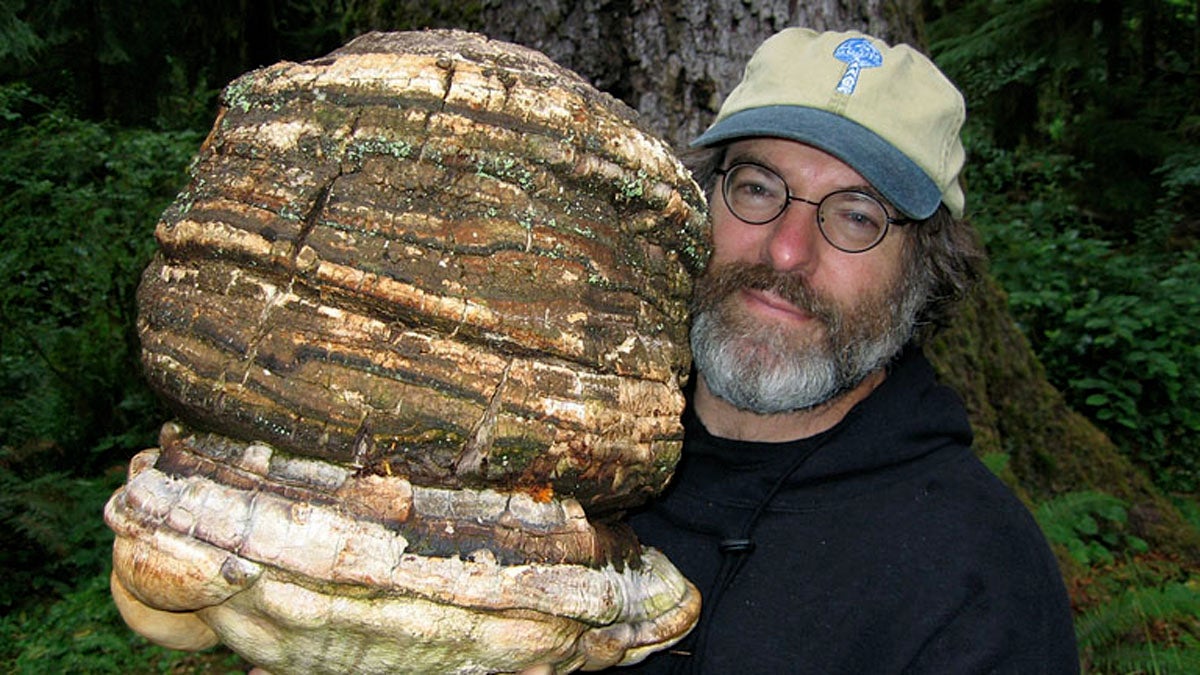Could mushrooms save the world?
Listen
Paul Stamets holding an Agarikon mushroom (Photo courtesy of Dusty Yao)
Mycologist Paul Stamets explains what fungi do for the planet and how they could be used to correct many of the problems that ail us.
Mycologist Paul Stamets wears a cool Indiana Jones-like hat, fitting for a researcher who is adored like a rock star by fans of his work. The hat is made from a mushroom – birch polypore – but it’s not the only mushroom Stamets has brought to the studio with him. Tucked into his backpack is a huge, 40-pound mushroom called Agarikon, which looks a bit like a beehive.
“It’s really hard. It sounds like wood; it feels like wood; it’s the longest living mushroom in the world,” Stamets explains.
Understanding the role of fungi
Stamets’ long research career has been devoted to understanding the role of fungi in our ecosystem, but he also sees himself as a mushroom ambassador.
“They come up so quickly and most of them disapear within five days,” he said. “It’s hard to understand something that can feed you, kill you, send you on a spiritual journey, and heal you. Something so potent can be so ephemeral.” As a result, he argues, people have long feared and misunderstood mushrooms. “There has been a lag in our public understanding of mushrooms as a result.”
Stamets lives and researches in Kamilche Point, Washington, and owns a company called Fungi Perfecti. His entire career has been dedicated to better understanding fungi, and he’s also a tireless mushroom ambassador – explaining what fungi do for the planet, and making a case that they could be used to correct many of the problems that ail us.
The scientific definition of a mushroom is a fungus that reproduces spores with a fleshy structure – if you can see it and feel it and it’s fleshy, then it is a mushroom-forming fungus.
“Mushrooms are like the fruit of the fungus like the apple is the fruit of the tree, and mycellium is the root like structure that gives rise to the mushroom,” explained Stamets. He says about 14,000 species of mushrooms are known, but DNA analysis suggests there are 150,000 species out there. “So we have identified only 10 percent of mushrooms in our ecosystem,” said Stamets.
Fungi to the rescue
Many fungi can’t be seen with the naked eye, and they don’t produce fruit bodies, but they play an important role in our ecosystem.
“Ninety percent of all plants are infused with mushrooms, plants have fungi in their roots, within their structure, and then there are fungi that break down the debris. They are the molecular decomposers of nature,” said Stamets.
Stamets believes mushrooms could play a huge role in addressing some of the world’s most pressing problems, such as pollution and illness.
“Mushrooms can break down bacteria, for example ecoli and staph,” he said. “They can break down pollutants, herbicides, and oil slicks.” Stamets has invented technologies to clean up oil spills, “myco-booms” that can float in water and break down oil slicks.
He is also exploring the anti-viral and anti-microbial properties of mushrooms like the Agarikon.
“The CDC has contacted us because they are completely freaked out by drug resistant strains of pathogens evolving in hospitals,” he said. “There are no good new antibiotics on the horizon, and what some of these mushrooms have to offer is a complexity of antiviral compounds.”
Stamets says for years, his research was more on the fringes of the scientific community, but the interest in the human microbiome project has brought more attention to the role of fungi.
Stamets encourages people to get more familiar with fungi, and to appreciate their omnipresence in our ecosystem.
“Go outside, find an old log, tip it over there is mycellium everywhere,” he said.
WHYY is your source for fact-based, in-depth journalism and information. As a nonprofit organization, we rely on financial support from readers like you. Please give today.




